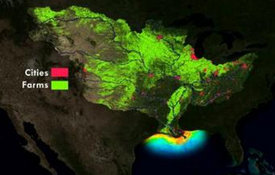http://www.commondreams.org/headline/2011/06/15-8
Published on Wednesday, June 15, 2011
by Doyle Rice
The “Dead Zone” in the Gulf of Mexico – a region of oxygen-depleted water off the Louisiana and Texas coasts that is harmful to sea life and the commercial fishing industry – is predicted to be the largest ever recorded this year, federal scientists announced Tuesday.
The majority of land in the Mississippi’s watershed is farm land (in green). Each spring, as farmers fertilize their land in preparation for crop season, rain washes fertilizer off the land and into streams, rivers, and then the Gulf of Mexico. This leads to a Dead Zone in the Gulf. (NOAA)
The majority of land in the Mississippi’s watershed is farm land (in green). Each spring, as farmers fertilize their land in preparation for crop season, rain washes fertilizer off the land and into streams, rivers, and then the Gulf of Mexico. This leads to a Dead Zone in the Gulf. (NOAA) The unusually large size of the zone is due to the extreme flooding of the Mississippi River this spring.
The Dead Zone occurs when there is not enough oxygen in the water to support marine life. Also known as “hypoxia,” it is created by nutrient runoff, mostly from over-application of fertilizer on agricultural fields. It flows into streams, then rivers and eventually the Gulf.
Forty-one percent of the contiguous USA drains into the Mississippi River and then out to the Gulf of Mexico. The majority of the land in Mississippi’s watershed is farm land.
Excess nutrients such as nitrogen can spur the growth of algae, and when the algae die, their decay consumes oxygen faster than it can be brought down from the surface, according to NOAA. As a result, fish, shrimp and crabs can suffocate, threatening the region’s commercial fishing industry.
Scientists say the area could measure between 8,500 and 9,421 square miles, or an area about the size of New Hampshire. If it does reach those levels, it would be the largest since mapping of the Gulf Dead Zone began in 1985.
The largest Dead Zone on record occurred in 2002 and encompassed more than 8,400 square miles. On average, the Dead Zone size is estimated to be 6,000 square miles.
